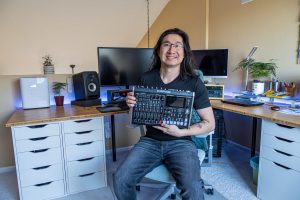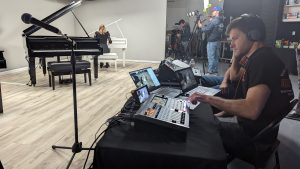- Roland has produced Pro A/V products for business and commercial use for decades.
- The V-5 and the VR-4 switchers were breakthrough products for Roland.
- Engineer Masayuki Hirase was at the forefront of the development process for these products, drawing influences from many sources.
Over the last two and a half decades, Roland video products have steadily gained industry prominence. From livestreaming to massive events, professionals worldwide rely on Roland switchers. The company has produced video products for almost half its history, with 2023 marking the 25th anniversary of the first Roland switcher. Masayuki Hirase, the developer of Roland’s first hardware video switcher, discusses the V-5 and V-4 and his involvement in their creation.
Early Days
Tell us how you developed the V-5, the first Roland switcher.
Masayuke Hirase: I used to work in a department that made electronic drums and rhythm machines, so we had the technology to produce sound by hitting pads. While trying to make something different using that technology, we devised a plan to create a device that could play back sound effects in time with live video. It was applause and cheering in a way that matched the video.
At that time, a department called the Tokyo Technical Center established itself. Several engineers from other manufacturers joined the company. One of them was someone who could design video equipment for broadcasting.
They designed a frame synchronizer for video. We made a board that used a general-purpose logic IC and wired it to a two-square-meter base. Then, we switched between two analog video signals that were out of sync. Our starting point was combining an audio player with video technology to create an exciting product.
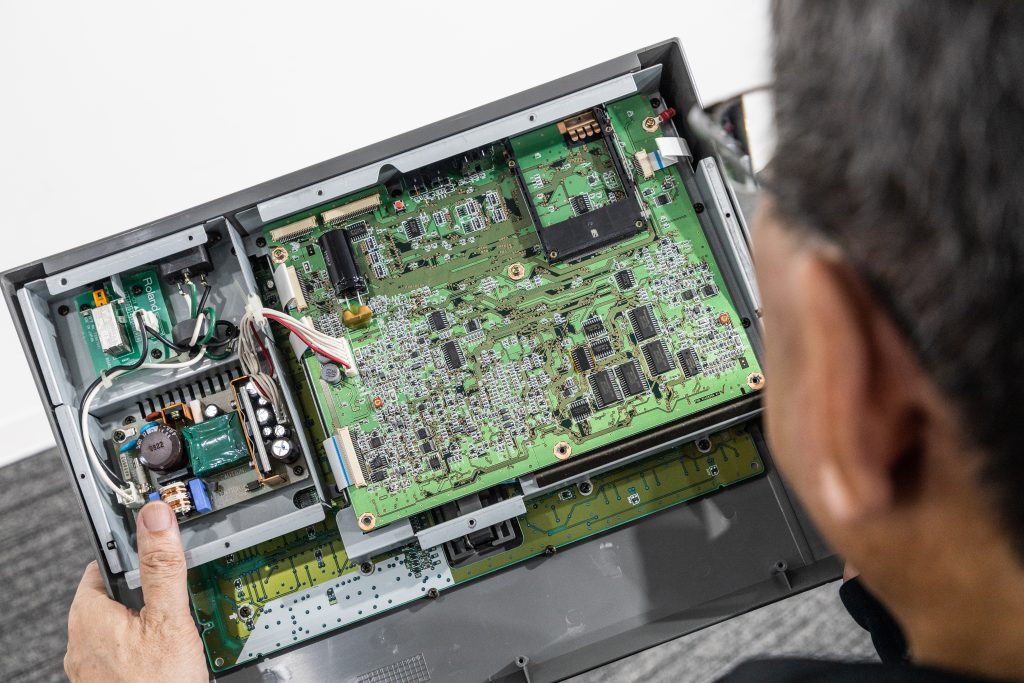
Roland had no video technology before that, correct?
Hirase: There was one, to be precise. Before the V-5 came out, there was a product called Video-kun. It was a combination of a hardware board and software that users ran on a PC. I wanted to know if creating a DTV in a similar form was possible, so I created it.
Was Video-kun a switcher combined with a PC, or just a hardware capture board?
Hirase: No, Video-kun was a linear editing machine controlling VTR with a built-in video processing function. There was a one-frame synchronizer on the video switcher V-5. Customers could switch between two video signals by synchronizing the other to the primary signal.
I made a board that used a general-purpose logic IC and wired it to a two-square-meter base. Our starting point was combining an audio player with video technology to create an exciting product.
Masayuke Hirase
A New Market
At that time, there was no livestreaming. The big market was production switchers for linear analog video editing from videotape. Was the V-5 a response to existing production switchers?
Hirase: Yes. However, when Roland started in the video switcher market, we wondered whether video editing equipment was a good choice. There were a variety of production switchers from major video manufacturers like Sony or Grass Valley on the market.
At the same time, VJs (visual jockeys) were becoming popular in clubs. VJs did visual performances with sound. The purpose of the V-5 project was to create a switcher that could do that with Roland quality.
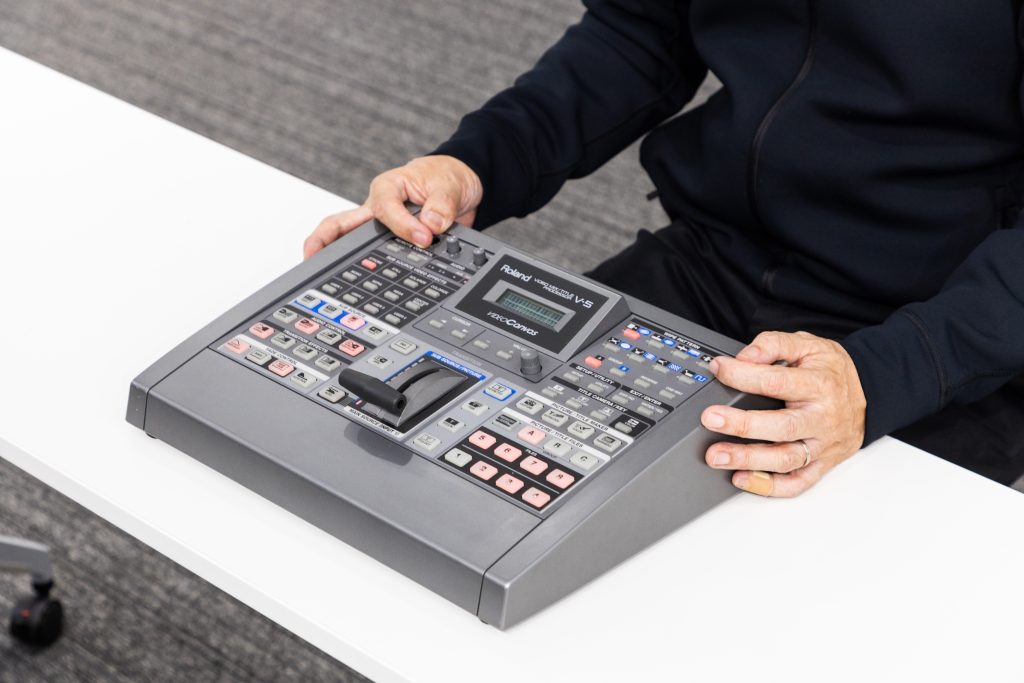
Unique Features
The V-5 control panel is clearly a switcher because of the wipe patterns and effects. However, the unit was unique from existing switchers.
Hirase: The primary feature was switching between two images to the last. But as an editorial element, I included TELOP (TELevision OPtical Slide Projector) or the ability to produce a still image.
The other addition was a video effect, which we created with a gate array circuit. The wipe function was a unique feature that used images stored in memory as alpha channels. Until then, the wipe function had been linear switching. One of the big V-5 features was the ability to wipe using the alpha channel recorded in the memory.
Was there a demand for unique video switching back then?
Hirase: Yes. At that time, there were various high-end production switchers based on digital processors on the market. We longed for amazing switching effects and wanted to do the more complicated wiping. However, we wanted to make it a product for VJs too, so we included a wipe function users could customize.
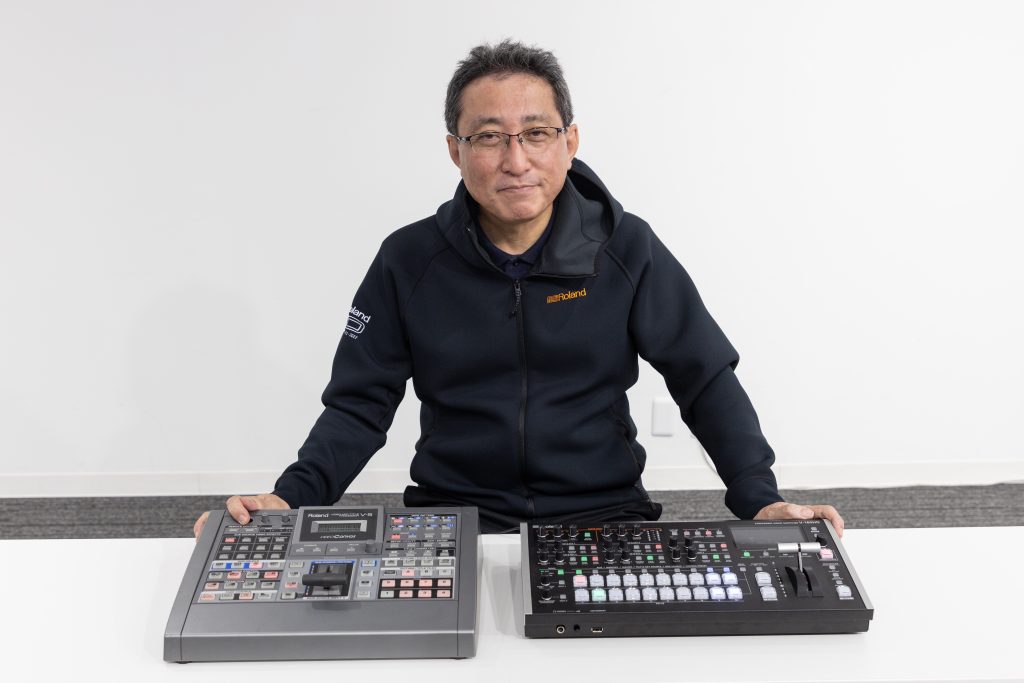
What about the user interface?
Hirase: Since it was a 2-input switcher, it was good to have a symmetrical shape that was easy to operate, so I put the T-bar as the center. However, I had more than my original functions when I arranged the switches like this. I had concerns about how to fill them up. I asked many people, and they gave me a lot of ideas. One of the unique features was the pre-start and audio-follow functions.
You could do split editing during a live performance, which you call linear editing.
Hirase: That was unique. Also, there was a TAP button to make automatic switching using BPM. This led to the V-4. When you tapped to the rhythm, the T-bar switched in time. I added functions I didn’t see in an ordinary switcher.
When we made V-5, I thought the symmetry was good. On cars, symmetrical features come from human references and look like an eye, a nose, and a mouth. The V-4 also has knobs, and the T-bar looks like a mouth holding a pipe.
Masayuke Hirase
A Big Hit
Roland’s second hardware switcher, the V-4, came out in 2002 and became the company’s first hit A/V product.
Hirase: It sold very well. Total production exceeded 30,000 units. In the blink of an eye, we sold 10,000 units, then 20,000, and finally, over 35,000, partly due to long-term sales.
Unlike the V-5, V-4 T-bar units can be rotated horizontally or vertically.
Hirase: I took the plunge to steer this entirely and turn it into a dedicated VJ performance tool. However, the manager at the time strongly desired to create an editing machine, so we worked hard internally to negotiate.
So, the V-5 was a production switcher, while the V-4 was a live switcher.
Hirase: When we made V-5, I thought the symmetry was good. On cars, symmetrical features come from human references and look like an eye, a nose, and a mouth. The V-4 also has knobs, and the T-bar looks like a mouth holding a pipe. When deciding what to base the VJ functions on, I used a DJ mixer as a reference. At that time, scratch DJ mixers were selling very well, and Roland also had DJ products like the DJ-1000 and DJ-2000.
For the DJ mixer, there are audio faders on the left and right, a crossfader in the middle, and a structure that finally goes out to the output. Incorporating that into the switcher was the best way for VJ performance. That way, there was a video switcher on the left and right and an independent effector. This meant they could switch an image instantly with a transform button to match the rhythm. And, like a DJ mixer, I put a fader on the final output.
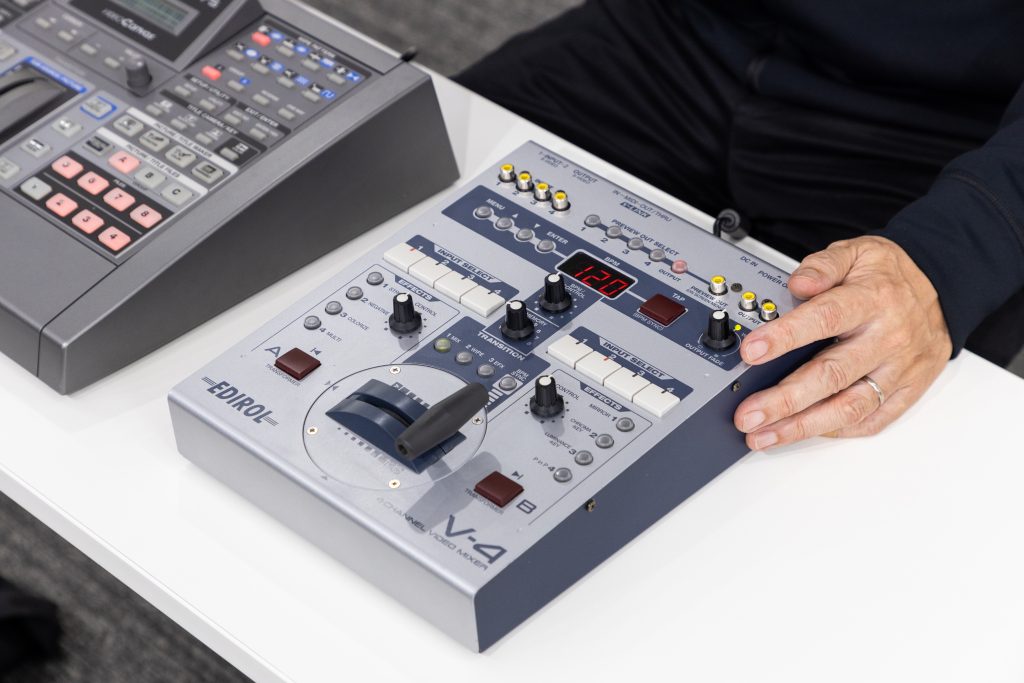
New Additions
It’s not an audio fader, rather a T-bar, correct?
Hirase: After the V-4 came out, we came out with a unique slide feeder as an option. I also made acrylic panels that attached to the surface as an option, so there was quite a bit of work. We were putting all our efforts into V-4.
Is the round switch a synthesizer?
Hirase: Yes. I wanted to boost the VJ scene, so I tried to lower the price. That was a big goal, so we had to figure out all the material costs, make the main board as small as possible, and select all the parts.
Ironclad
The body of the V-5 was plastic, but the V-4 was rigid iron. Was this to increase strength?
Hirase: There were iron plates in the factory. An audio mixer got developed in our same center, but sales were not good. Our bottom iron plate was the same material as the mixer. The factory bought the material as a roll, making it difficult to use for the mixer. We made the V-4 from recycled material. Ironically, the stock of recycled materials ran out so quickly that they had to repurchase them for additional production.
From middle of noughties, the era of digital inputs and outputs was coming. The world changed significantly. If we wanted a production switcher, we needed a deeper product, so we developed converters like the VC-300HD and VC-200HD.
Masayuke Hirase
Switcher History
Roland’s hardware video products began with VJs, moved to broadcasting, and finally gained a foothold with livestreaming.
Hirase: Based on technology from the V-4, we also made production switchers like the LS-400 and LVS-800. The technology inside was the same, but there were two lineups: one for VJs and the other for production. However, the VJ era was closing. Starting from the middle of the noughties, the era of digital inputs and outputs was coming. The world changed significantly. If we wanted a production switcher, we needed a deeper product, so we developed converters like the VC-300HD and VC-200HD.
We also made the V-440HD, a switcher that mixed analog HD and SD, as the follow-up product after the converter. It was a moderate hit. Next, we developed the V-1600HD and V-800HD with digital inputs like SDI as event switchers.
In broadcasting, there is a philosophy that SD and HD should not get mixed. The V-440HD can handle both.
Hirase: We connected to the event industry by putting that product out. We asked about their work, needs, and desired functions. This led to the birth of the next multi-format live switcher, the V-800HD. Primarily, the event industry needed a switcher for live shows. But it’s durable enough to use in production.


